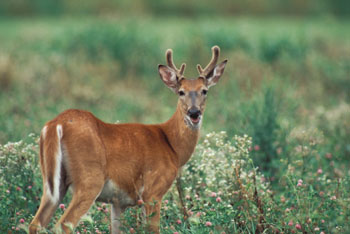
By Dan Zarlenga, Missouri Department of Conservation
Photo caption: A male whitetail deer shows off its developing antlers, sheathed in nourishing velvet. Photo by Jim Rathert, Missouri Department of Conservation
One might think that donning extra hair in the middle of summer would be considered “fuzzy logic”. But it turns out that for male whitetail deer, it makes perfect sense.
Male whitetail deer are usually the only ones that can grow those magnificent antlers, which appear and shed each year in a predictable cycle. They are essentially seasonal bones that grow on the outside of their bodies. In fact, antlers are the fastest-growing bones that scientists know of. A male deer’s antlers increase in size by about a quarter inch per day!
It all starts around April, when the antlers begin to appear. Their growth is stimulated by increasing daylight and fueled by a bump in the production of testosterone within the deer’s body. How much do they grow? Genetics and age play a role, but one of the biggest determiners is good nutrition. Enjoying a healthy and protein rich diet can help a buck produce an incredible rack that becomes more impressive the older he gets.
The emerging antlers start as cartilage that is covered in skin with a short, dense fur called velvet. The name comes from this fur’s short, yet ultra plush quality. It truly looks and feels like the fabric from which it’s named. It does much more than look pretty though. The tissue under the velvet carries oxygen rich blood to the growing antlers, which enables the cartilage to calcify and harden into bone.
The antlers continue to grow throughout the spring and summer, covered in this fuzzy, nurturing velvet. So yes, male deer do indeed wear this extra hair during the warmest part of the year.
Come August, the antlers reach their final size. Now, the velvet has served its purpose and is no longer useful. It dries and becomes itchy, causing the buck to feel discomfort and decide it needs a “haircut”. At this time, the male whitetail vigorously rubs its newly formed antlers on trees, saplings, stumps, and other vegetation to scrape the velvet off. Since velvet is skin, rubbing it off can look a bit gruesome. But thankfully a white-tailed deer can remove all its velvet within a day or so, so the unpleasantness doesn’t last long. And what’s left is a shiny new set of antlers.
What’s the purpose of antlers anyway? That becomes apparent in the fall, during the breeding season, or rut. Male deer rub their antlers on vegetation to mark their scent. They also use them to show off to females and challenge other males for mating rights. Two bucks may dramatically clash antlers, rattling and sparring for dominance. This is an essential part of whitetail deer social behavior.
After the mating season is over, the antlers have served their purpose. Decreased daylight prompts a drop in testosterone, which causes the connection between the antler and the skull to weaken. The antler falls off. This sheds up to nine pounds of excess weight, giving the deer more energy to negotiate the challenges of winter.
Seen as a fascinating adaptive strategy, the logic of a male deer wearing velvet in the middle of summer is anything but fuzzy.


